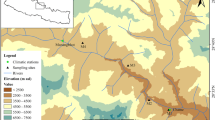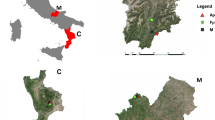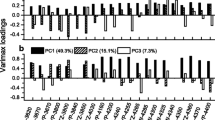Abstract
Patterns in radial growth have often been used to predict forest decline since they are regarded as indicators of the tree responses to long-term stressors. However, the sensitivity of tree growth to climate, as a proxy of the trees’ adaptive capacity to short-term climatic stress, has received less attention. Here, we used retrospective tree-ring analyses to determine whether growth patterns and sensitivity to climate are related to Abies alba (silver fir) decline in the Spanish Pyrenees. We used regional climatic data to calculate normalised temperatures and drought indexes. Basal-area increment (BAI) was measured for declining (defoliation >50%) and non-declining (defoliation <50%) silver firs in four stands with contrasting decline levels. A dynamic factor analysis (DFA) was applied to test the hypothesis that declining and non-declining trees have experienced different long-term growth trends. Growth sensitivity to climate was computed as the average change in BAI per unit of change in a given climate variable. Declining trees showed a negative growth trend during the last 20 years. Trees with lower relative BAI and negative BAI trends showed stronger growth sensitivity to climate and higher defoliation than trees with the opposite characteristics. Our findings underscore the idea that long-term climatic warming seems to be a major driving factor of growth decline in Pyrenean silver fir forests. Ongoing growth reduction and enhanced growth sensitivity to climate may promote vegetation shifts in these declining forests located near the xeric edge of the species distribution area.







Similar content being viewed by others
References
Akaike H (1974) A new look at statistical model identification. IEEE Trans Autom Control 19:716–722
Andreu L, Gutiérrez E, Macias M, Ribas M, Bosch O, Camarero JJ (2007) Climate increases regional tree-growth variability in Iberian pine forests. Glob Chang Biol 13:1–12
Atkin OK, Bruhn D, Hurry VM, Tjoelker MG (2005) The hot and the cold: unravelling the variable response of plant respiration to temperature. Funct Plant Biol 32:87–105
Aussenac G (2002) Ecology and ecophysiology of circum-Mediterranean firs in the context of climate change. Ann For Sci 59:823–832
Becker M, Landmann G, Lévy G (1989) Silver fir decline in the Vosges mountains (France): role of climate and silviculture. Water Air Soil Poll 48:77–86
Bigler CJ, Bugmann H (2004) Predicting the time of tree death using dendrochronological data. Ecol Appl 14:902–914
Bigler CJ, Gricar J, Bugmann H, Cufar K (2004) Growth patterns as indicators of impending tree death in silver fir. For Ecol Manag 199:183–190
Bigler CJ, Bräker OU, Bugmann H, Dobbertin M, Rigling D (2006) Drought as an inciting mortality factor in Scots pine stands of the Valais, Switzerland. Ecosystems 9:330–343
Bigler CJ, Gavin DG, Gunning C, Veblen TT (2007) Drought induces lagged tree mortality in a subalpine forest in the Rocky Mountains. Oikos 116:1983–1994
Biondi F, Qaedan F (2008) A theory-driven approach to tree-ring standardization: defining the biological trend from expected basal area increment. Tree-Ring Res 64:81–96
Buchman RG, Pederson SP, Walters NR (1983) A tree survival model with application to species of the Great Lakes region. Can J For Res 13:601–608
Cabrera M (2001) Evolución de abetares del Pirineo aragonés. Cuadernos de la Sociedad Española de Ciencias Forestales 11:43–52
Camarero JJ (2000) El decaimiento del abeto en los Pirineos. Medio Ambiente Aragón 4:18–20
Camarero JJ, Padró A, Martín-Bernal E, Gil-Pelegrín E (2002) Aproximación dendroecológica al decaimiento del abeto (Abies alba Mill.) en el pirineo Aragonés. Montes 70:26–33
Camarero JJ, Bigler CJ, Linares JC, Gil-Pelegrín E (2011) Synergistic effects of past historical logging and drought on the decline of Pyrenean silver fir forests. For Ecol Manag 262:759–769
Carnicer J, Coll M, Ninyerola M, Pons X, Sánchez G, Peñuelas J (2011) Widespread crown condition decline, food web disruption, and amplified tree mortality with increased climate change-type drought. PNAS 119:1515–1525
Carrer M, Nola P, Motta R, Urbinati C (2010) Contrasting tree-ring growth to climate responses of Abies alba toward the southern limit of its distribution area. Oikos 119:1515–1525
Clark JS (2003) Uncertainty and variability in demography and population growth: a hierarchical approach. Ecology 84:1370–1381
Das AJ, Battles JJ, Stephenson NL, van Mantgem PJ (2007) The relationship between tree growth patterns and likelihood of mortality: a study of two tree species in the Sierra Nevada. Can J For Res 37:580–597
Dobbertin M (2005) Tree growth as indicator of tree vitality and of tree reaction to environmental stress: a review. Eur J For Res 124:319–333
Franklin JF, Shugart HH, Harmon ME (1987) Tree death as an ecological process. Bioscience 37:550–556
Fritts HC (1976) Tree rings and climate. Academic Press, London
Galiano L, Martinez-Vilalta J, Lloret F (2010) Drought-induced multifactor decline of Scots pine in the Pyrenees and potential vegetation change by the expansion of co-occurring oak species. Ecosystems 7:978–991
Greenwood DL, Weisberg PJ (2008) Density-dependent tree mortality in pinyon-juniper woodlands. For Ecol Manag 255:2129–2137
Holmes RL (1983) Computer-assisted quality control in tree-ring dating and measurement. Tree-Ring Bull 43:68–78
Holmes RL (1992) Dendrochronology program library. Laboratory of Tree-Ring Research, University of Arizona, Tucson
Jactel H, Brockerhoff E, Duelli P (2005) A test of the biodiversity-stability theory: meta-analysis of tree species diversity effects on insect pest infestations, and re-examination of responsible factors. For Div Funct Temp Boreal Syst 176:235–262
Kobe RK, Coates KD (1997) Models of sapling mortality as a function of growth to characterize interspecific variation in shade tolerance of eight tree species of northwestern British Columbia. Can J For Res 27:227–236
Linares JC, Camarero JJ (2011) From pattern to process: linking intrinsic water-use efficiency to drought induced forest decline. Glob Change Biol. doi:10.1111/j.1365-2486.2011.02566.x
Linares JC, Tíscar PA (2010) Climate change impacts and vulnerability of the southern populations of Pinus nigra subsp. salzmannii. Tree Physiol 30:795–806
Linares JC, Camarero JJ, Carreira JA (2010) Competition modulates the adaptation capacity of forests to climatic stress: Insights from recent growth decline and death in relict stands of the Mediterranean fir Abies pinsapo. J Ecol 98:592–603
Linares JC, Delgado-Huertas A, Carreira JA (2011) Climatic trends and different drought adaptive capacity and vulnerability in a mixed Abies pinsapo—Pinus halepensis forest. Clim Chang 105:67–90
Litton C, Raich JW, Ryan MG (2007) Carbon allocation in forest ecosystems. Glob Chang Biol 13:2089–2109
Macias M, Andreu L, Bosch O, Camarero JJ, Gutiérrez E (2006) Increasing aridity is enhancing silver fir Abies alba (Mill.) water stress in its south-western distribution limit. Clim Chang 79:289–313
Manion PD (1991) Tree disease concepts. Prentice-Hall, Englewood Cliffs
Miyamoto Y, Griesbauer HP, Green DS (2010) Growth responses of three coexisting conifer species to climate across wide geographic and climate ranges in Yukon and British Columbia. For Ecol Manag 259:514–523
Müller EHR, Stierlin HR (1990) Sanasilva tree crown photos with percentages of foliage loss. WSL, Birmensdorf
Ogle K, Whitham TG, Cobb NS (2000) Tree-ring variation in pinyon predicts likelihood of death following severe drought. Ecology 81:3237–3243
Pedersen BS (1998a) Modeling tree mortality in response to short and long-term environmental stresses. Ecol Model 105:347–351
Pedersen BS (1998b) The role of stress in the mortality of Midwestern oaks as indicated by growth prior to death. Ecology 79:79–93
Peñuelas J, Ogaya R, Boada M, Jump AS (2007) Migration, invasion and decline: changes in recruitment and forest structure in a warming-linked shift of European beech forest in Catalonia (NE Spain). Ecography 30:830–838
Pinto PE, Gegout JC (2005) Assessing the nutritional and climatic response of temperate tree species in the Vosges mountains. Ann For Sci 62:761–770
Pinto PE, Gegout JC, Herve JC, Dhote JF (2008) Respective importance of ecological conditions and stand composition on Abies alba Mill. dominant height growth. For Ecol Manage 255:619–629
R Development Core Team (2011) R: a language and environment for statistical computing. R Foundation for Statistical Computing, Vienna, Austria. ISBN 3-900051-07-0. http://www.R-project.org
Rathgeber CBK, Rossi S, Bontemps JD (2011) Cambial activity related to tree size in a mature silver-fir plantation. Ann Bot 108:429–438
Sarris D, Christodoulakis D, Körner C (2007) Recent decline in precipitation and tree growth in the eastern Mediterranean. Glob Chang Biol 13:1–14
Solberg S (2004) Summer drought: a driver for crown condition and mortality of Norway spruce in Norway. For Pathol 34:93–104
Taberlet P, Cheddadi R (2002) Quaternary refugia and persistence of biodiversity. Science 297:2009–2010
Tardif J, Camarero JJ, Ribas M, Gutiérrez E (2003) Spatiotemporal variability in tree ring growth in the Central Pyrenees: climatic and site influences. Ecol Monogr 73:241–257
Torelli N, Shortle WC, Cufar K, Ferlin F, Smith KT (1999) Detecting changes in tree health and productivity of silver fir in Slovenia. Eur J For Pathol 29:189–197
van Mantgem PJ, Stephenson NL, Mutch LS, Johnson VG, Esperanza AM, Parsons DJ (2003) Growth rate predicts mortality of Abies concolor in both burned and unburned stands. Can J For Res 33:1029–1038
van Mantgem PJ, Stephenson NL, Byrne JC et al (2009) Widespread increase of tree mortality rates in the western United States. Science 323:521–524
Vieilledent G, Courbaud B, Kunstler G, Dhôte J-F (2010) Mortality of silver fir and norway spruce in the western Alps—a semi-parametric approach combining size-dependent and growth-dependent mortality. Ann For Sci 67:305
Villalba R, Veblen TT (1998) Influences of large-scale climatic variability on episodic tree mortality in northern Patagonia. Ecology 79:2624–2640
Waring RH (1987) Characteristics of trees predisposed to die. Bioscience 37:569–574
Willmott CJ, Rowe CM, Mintz Y (1985) Climatology of the terrestrial seasonal water cycle. Int J Climatol 5:589–606
Wunder J, Reineking B, Bigler CJ, Bugmann H (2008) Predicting tree mortality from growth data: how virtual ecologists can help real ecologists. J Ecol 96:174–187
Wyckoff PH, Clark JS (2000) Predicting tree mortality from diameter growth: a comparison of maximum likelihood and Bayesian approaches. Can J For Res 30:156–167
Zuur AF, Fryer RJ, Jolliffe IT, Dekker R, Beukema JJ (2003) Estimating common trends in multivariate time series using dynamic factor analysis. Environmetrics 14:665–685
Acknowledgments
This study was funded by project RTA01-071-C3-1 (INIA, Spain) and Gob. Aragón. We thank E. Martin, J.L. Vázquez, C. Lastanao and M.A. Pascual for their help. We also thank two anonymous reviewers for his helpful comments and discussions. J.J.C. acknowledges the support of ARAID and an ETH guest scientist grant. We thank AEMET for providing climatic data. This work is humbly dedicated to Ceci and Blanquita.
Author information
Authors and Affiliations
Corresponding author
Additional information
Communicated by C. Ammer.
Electronic supplementary material
Below is the link to the electronic supplementary material.
Rights and permissions
About this article
Cite this article
Linares, J.C., Camarero, J.J. Growth patterns and sensitivity to climate predict silver fir decline in the Spanish Pyrenees. Eur J Forest Res 131, 1001–1012 (2012). https://doi.org/10.1007/s10342-011-0572-7
Received:
Revised:
Accepted:
Published:
Issue Date:
DOI: https://doi.org/10.1007/s10342-011-0572-7




